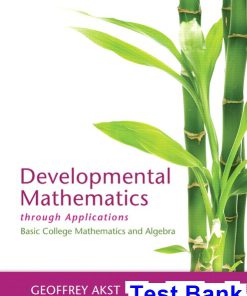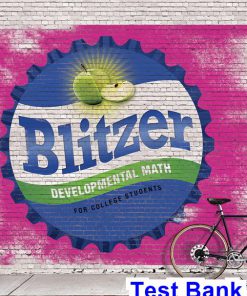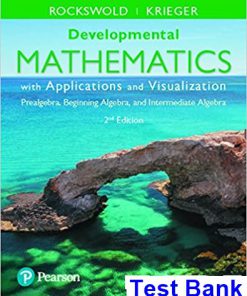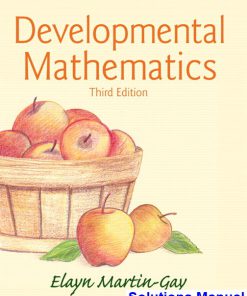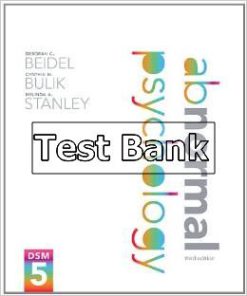Interactive Developmental Mathematics 1st Edition Rockswold Test Bank
$26.50$50.00 (-47%)
Interactive Developmental Mathematics 1st Edition Rockswold Test Bank.
You may also like
-
$26.50
$50.00
Instant download Interactive Developmental Mathematics 1st Edition Rockswold Test Bank pdf docx epub after payment.

Product details:
- ISBN-10 : 0134380002
- ISBN-13 : 978-0134380001
- Author:
Gary Rockswold and Terry Krieger give meaning to the numbers that students encounter by developing concepts in context through the use of applications, multiple representations, and visualization. By seeing the concept in context before being given the mathematical abstraction, students make math part of their own experiences instead of just memorizing techniques. Research is showing that this method is essential to empowering students. Seamlessly integrated real-life connections, graphs, tables, charts, and meaningful data help students deepen understanding and prepare for future math courses―and life―by teaching them critical thinking and problem-solving skills.
Table of contents:
1. Whole Numbers
1.1 Introduction to Whole Numbers
1.2 Adding and Subtracting Whole Numbers; Perimeter
1.3 Multiplying and Dividing Whole Numbers; Area
1.4 Exponents, Variables, and Algebraic Expressions
1.5 Rounding and Estimating; Square Roots
1.6 Order of Operations
1.7 More with Equations and Problem Solving
2. Integers
2.1 Integers and the Number Line
2.2 Adding Integers
2.3 Subtracting Integers
2.4 Multiplying and Dividing Integers
2.5 Order of Operations; Averages
2.6 Solving Equations That Have Integer Solutions
3. Algebraic Expressions and Linear Equations
3.1 Simplifying Algebraic Expressions
3.2 Translating Words to Expressions and Equations
3.3 Properties of Equality
3.4 Solving Linear Equations in One Variable
3.5 Applications and Problem Solving
4. Fractions
4.1 Introduction to Fractions and Mixed Numbers
4.2 Prime Factorization and Lowest Terms
4.3 Multiplying and Dividing Fractions
4.4 Adding and Subtracting Fractions–Like Denominators
4.5 Adding and Subtracting Fractions–Unlike Denominators
4.6 Operations on Mixed Numbers
4.7 Complex Fractions and Order of Operations
4.8 Solving Equations Involving Fractions
5. Decimals
5.1 Introduction to Decimals
5.2 Adding and Subtracting Decimals
5.3 Multiplying and Dividing Decimals
5.4 Real Numbers, Square Roots, and Order of Operations
5.5 Solving Equations Involving Decimals
5.6 Applications from Geometry and Statistics
6. Ratios, Proportions, and Measurement
6.1 Ratios and Rates
6.2 Proportions and Similar Figures
6.3 The U.S. System of Measurement
6.4 The Metric System of Measurement
6.5 U.S.-Metric Conversions; Temperature
6.6 Time and Speed
7. Percents
7.1 Introduction to Percent; Circle Graphs
7.2 Using Equations to Solve Percent Problems
7.3 Using Proportions to Solve Percent Problems
7.4 Applications: Sales Tax, Discounts, and Net Pay
7.5 Applications: Simple and Compound Interest
7.6 Probability and Percent Chance
8. Geometry
8.1 Plane Geometry: Points, Lines, and Angles
8.2 Triangles
8.3 Polygons and Circles
8.4 Perimeter and Circumference
8.5 Area, Volume, and Surface Area
9. Linear Equations and Inequalities in One Variable
9.1 Review of Linear Equations in One Variable
9.2 Further Problem Solving
9.3 Linear Inequalities in One Variable
10. Graphing Equations
10.1 Introduction to Graphing
10.2 Equations in Two Variables
10.3 Intercepts; Horizontal and Vertical Lines
10.4 Slope and Rates of Change
10.5 Slope-Intercept Form
10.6 Point-Slope Form
10.7 Introduction to Modeling
11. Systems of Linear Equations in Two Variables
11.1 Solving Systems of Linear Equations Graphically and Numerically
11.2 Solving Systems of Linear Equations by Substitution
11.3 Solving Systems of Linear Equations by Elimination
11.4 Systems of Linear Inequalities
12. Polynomials and Exponents
12.1 Rules for Exponents
12.2 Addition and Subtraction of Polynomials
12.3 Multiplication of Polynomials
12.4 Special Products
12.5 Integer Exponents and the Quotient Rule
12.6 Division of Polynomials
13. Factoring Polynomials and Solving Equations
13.1 Introduction to Factoring
13.2 Factoring Trinomials I (x2 + bx + c)
13.3 Factoring Trinomials II (ax2 + bx + c)
13.4 Special Types of Factoring
13.5 Summary of Factoring
13.6 Solving Equations by Factoring I (Quadratics)
13.7 Solving Equations by Factoring II (Higher Degree)
14. Rational Expressions
14.1 Introduction to Rational Expressions
14.2 Multiplication and Division of Rational Expressions
14.3 Addition and Subtraction with Like Denominators
14.4 Addition and Subtraction with Unlike Denominators
14.5 Complex Fractions
14.6 Rational Equations and Formulas
14.7 Proportions and Variation
15. Introduction to Functions
15.1 Functions and Their Representations
15.2 Linear Functions
15.3 Compound Inequalities and Piecewise-Defined Functions
15.4 Other Functions and Their Properties
15.5 Absolute Value Equations and Inequalities
16. Systems of Linear Equations16.1 Systems of Linear Equations in Three Variables
16.2 Matrix Solutions of Linear Systems
16.3 Determinants
17. Radical Expressions and Functions
17.1 Radical Expressions and Functions
17.2 Rational Exponents
17.3 Simplifying Radical Expressions
17.4 Operations on Radical Expressions
17.5 More Radical Functions
17.6 Equations Involving Radical Expressions
17.7 Complex Numbers
18. Quadratic Functions and Equations
18.1 Quadratic Functions and Their Graphs
18.2 Transformations and Translations of Parabolas
18.3 Quadratic Equations
18.4 The Quadratic Formula
18.5 Quadratic Inequalities
18.6 Equations in Quadratic Form
19. Exponential and Logarithmic Functions
19.1 Composite and Inverse Functions
19.2 Exponential Functions
19.3 Logarithmic Functions
19.4 Properties of Logarithms
19.5 Exponential and Logarithmic Equations
20. Conic Sections
20.1 Parabolas and Circles
20.2 Ellipses and Hyperbolas
20.3 Nonlinear Systems of Equations and Inequalities
21. Sequences and Series
21.1 Sequences
21.2 Arithmetic and Geometric Sequences
21.3 Series
21.4 The Binomial Theorem

